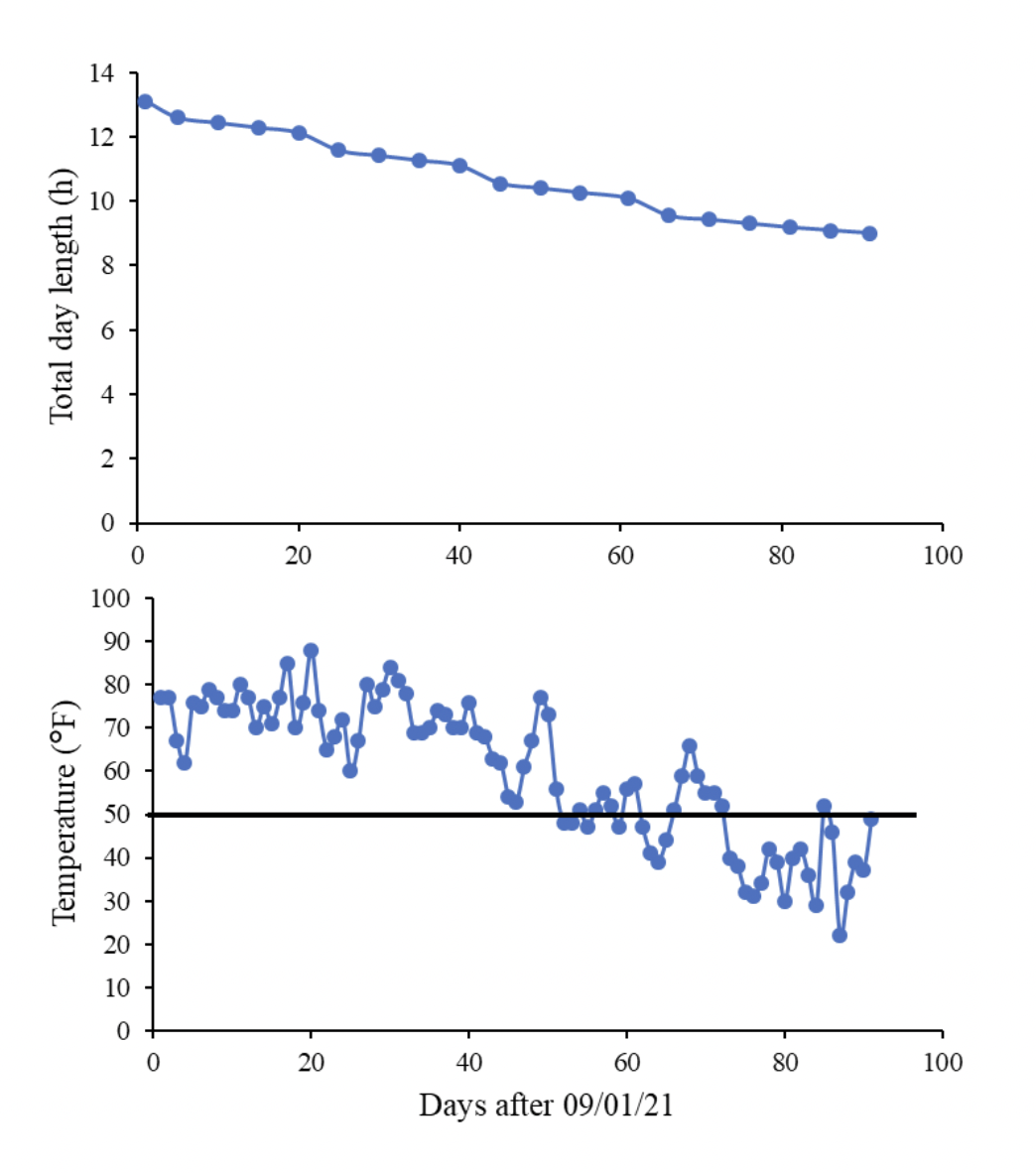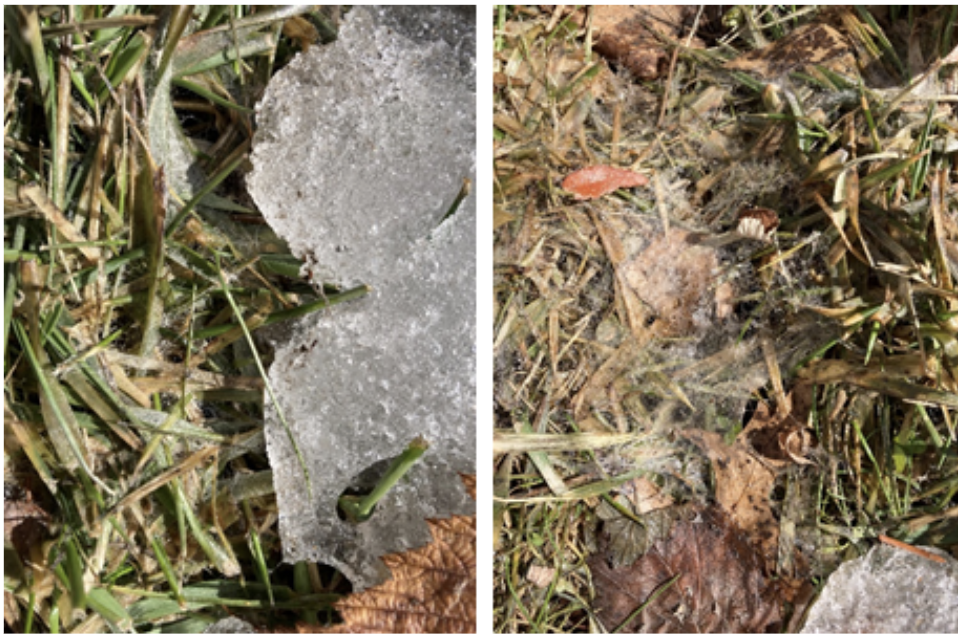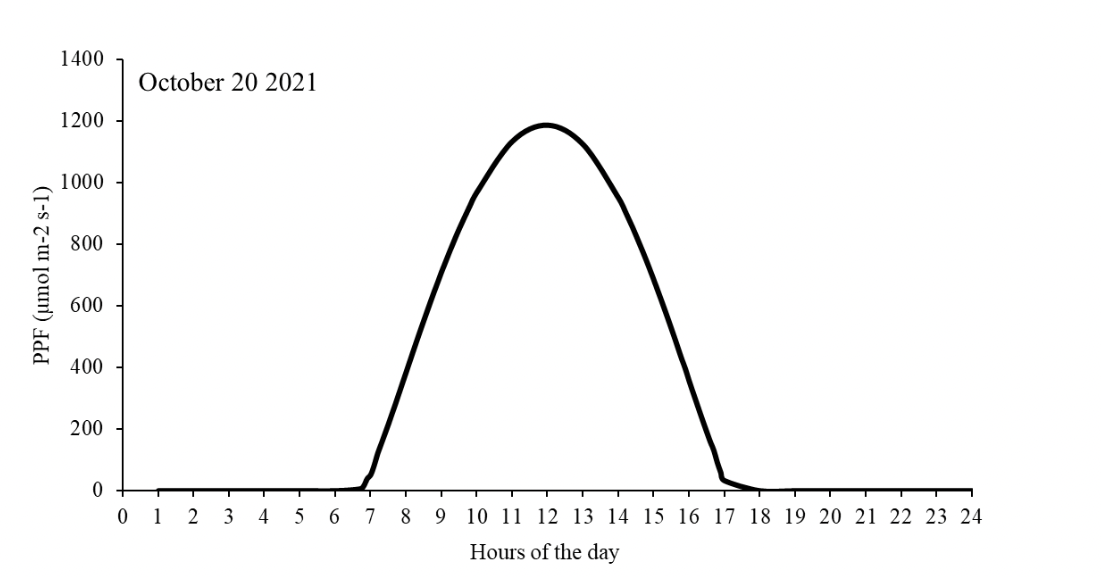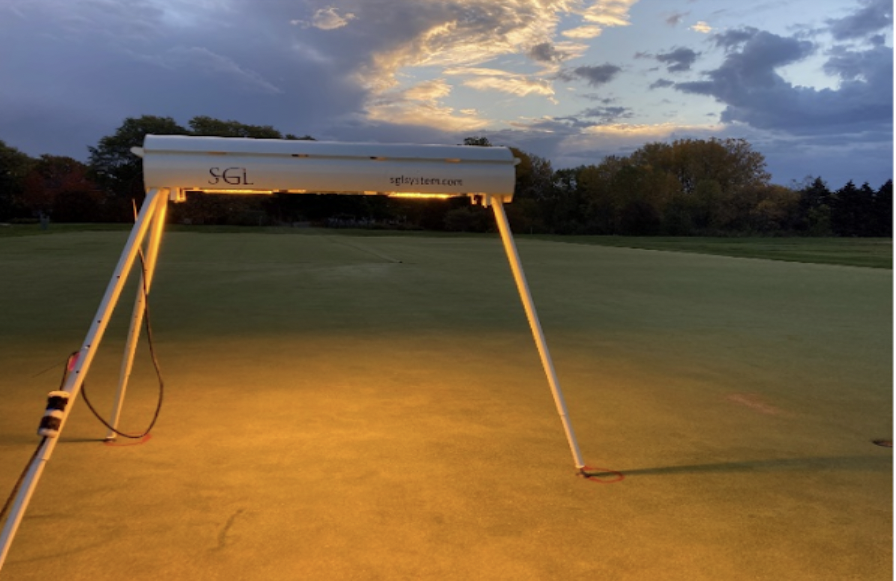By Florence Sessoms and Dominic Petrella
Snow mold is a famous early spring disease affecting many turfgrasses in particular annual bluegrass and creeping bentgrass. This disease is a concern for golf course superintendents as a lack of correct application of fungicide in the fall results, during the following spring, in the loss of green, tee or fairway areas. An alternative to chemical application is focused on improving the winter hardening of turfgrass species through the use of artificial lightning as further described.
The decrease in temperature that occurs in autumn (>50 ℉) is associated with a reduction in day length (Figure 1), and both are signals that lead to important plant physiological responses to prepare for the winter.
These plant hardening responses include changes in plant growth and height reduction, preference for nutrient storage in the root system, changes in the cellular metabolism, and accumulation of different types of sugars in various locations of the cell for better winter survival. This hardening period is extremely important for successful freezing tolerance and snow mold resistance during the winter months. Gaining freezing tolerance and snow mold resistance are triggered by similar environmental conditions (fall temperatures and light reduction) but regulated by different molecular pathways. It is important to keep in mind that a plant’s ability to be tolerant to frost/freeze does not indicate a snow mold resistance and vice versa.
Sugar-based snow mold resistance
This older concept involves the accumulation of carbohydrates, in particular fructans, during the hardening period for snow mold resistance during the winter months. Studies on winter cereal crops have shown that snow mold resistance could be associated with total carbohydrate content and specific types of carbohydrate for a few possible reasons:
- Hypothesis #1. Snow molds are pathogens that develop in cool temperatures (0°C - 5°C) and low-light environments created by snow cover or winter months (Figure 2). During these cool and low light periods, plant photosynthesis is reduced. Plants, therefore, heavily rely on their carbohydrate storage accumulated in the fall. A depletion of their carbohydrate storage would make a plant more susceptible to snow mold pathogens because of their reduced inability to fight the disease.
- Hypothesis #2. Fructan, a polymer of fructose, has been shown to accumulate in vegetative tissue during the hardening period as a future source of energy during the winter months and fructans also increase freeze tolerance by strengthening cell walls and decreasing cellular freeze points. This fructan accumulation was also associated with higher snow mold resistance. This complex polymer might be more difficult to be degraded and metabolized by snow mold pathogens. Hence, a higher presence of fructan (or certain types of fructan) might slow down the development of snow mold pathogens in plant tissue.
- Hypothesis #3. The accumulation of small-chained carbohydrates in the different cell compartments decreases cellular water potential and results in cell dehydration. This cellular dehydration protects the plant from further freezing damage occurring during winter. Interestingly, snow mold pathogens have shown optimal water potential for their development in plant tissues. A reduced cellular water potential could decrease their ability to develop in the plant tissue.
These different hypothetical mechanisms (carbohydrate accumulation, the presence of fructan, and reduced water potential) could work in synergy with each other for improved snow mold resistance and freezing tolerance (reduced water content). More research is needed to understand the involvement of these potential mechanisms in snow mold turfgrass resistance.
Why would artificial light help?
Snow mold resistance in winter wheat has been associated with increased photosynthetic activity during the hardening period but it has never been associated with increased photoperiod. The reduced day length occurring in the fall is also associated with a lower light intensity in the morning and evening of the day (Figure 3).
In general, photosynthetic cells positively respond with increased light intensity: higher light intensity, more photosynthesis; our hypothesis is that increasing the light intensity for a couple hours in the morning and afternoon could induce a longer window of efficient photosynthesis, resulting in higher carbohydrate accumulation each day during the hardening period. We are also making the assumption that the lower temperatures and unaltered fall photoperiod would maintain the same hardening cellular metabolism. Our goal is to increase specific carbohydrate accumulation with higher light availability during the hardening period to improve snow mold resistance.
Could artificial light be easily used?
Golf courses have started to use supplemental lighting more frequently to improve the playability of their greens, during the autumn season when light is more limiting. We are proposing to use a similar approach for improving snow mold resistance on bentgrass greens. Our experimental set-up will consist of the application artificial lighting at the beginning of the day (2 hours) and the end of day (2 hours) on an bentgrass green without changing the photoperiod during the 2 weeks when the temperatures start to be below 50 ℉ (typically late October through early November in Minnesota). The artificial lighting will be added by using the BU10 unit from SGL, outfitted with high pressure sodium lamps (Figure 4). These compact units, which are easily movable, can provide an additional light intensity of 250 umol.m-2.s-1 on a 10 square meters area and are already used on golf courses. Light-treated plots and control (no additional light) will be artificially inoculated with snow mold the day after ending the light treatment. In the later winter and early spring, after the snow melts, we’ll be able to see if our idea worked by comparing snow mold incidence on the turf areas that received extra light, with those that didn’t. We hope to see some positive results, but even if we don’t, our WinterTurf project team has a number of projects addressing ways to reduce snow mold on cool-season turfgrasses.
Control plots are situated far enough away from the light source so they’re not influenced by the extra light.



